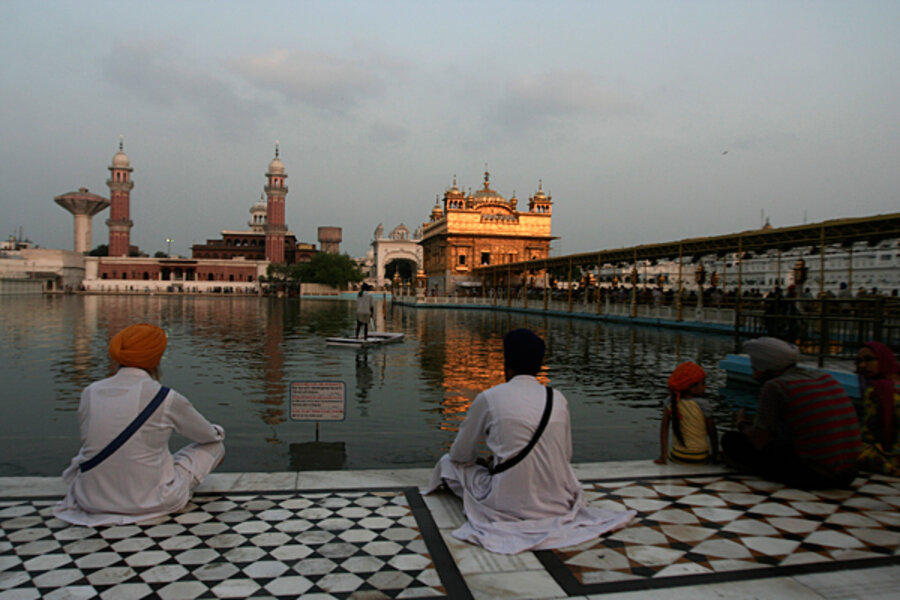Sikh temple shootings prompt calls for justice in US ... and India
Loading...
| New Delhi
Down an immaculately swept lane, just wide enough for two motorcycles to pass in the densely packed suburbs of West Delhi, Ranjit Singh’s family is still trying to come to terms with his murder at the Sikh temple in Oak Creek, Wisconsin.
Ranjit, father of three, and his brother Sita were both shot dead in Sunday’s mass shooting. Ranjit Singh had been in the United States for 16 years; Sita for only a few months. The shooter, Wade Michael Page, a known white supremacist and ex-US-army veteran, shot dead six people before he was killed by police.
In the Singh family’s tiny front room, open to mourners, friends and family sit on a covered cement floor in quiet disbelief. Their immediate concerns are to understand why this happened, and to adjust financially to a future without Ranjit, whose earnings in the US ran his Indian household.
India’s foreign minister called this week on the US government to do more to protect religious minorities, but some question that call, when India has yet to fully prosecute communal violence against both minority Muslims and Sikhs in recent decades.
"At least in America you can get justice,” says Harnam Singh, chief priest of the Bangla Sahib Gurudwara, one of New Delhi’s biggest Sikh temples.
"[American police] even killed this shooter, for which we should thank them. In India, 25 years pass, and nothing is decided. I don’t want to criticize my own country, but we all know this is what happens.”
This hits home because the Singh family have been targets of hate crimes before, right here in India.
In 1984, after then Prime Minister Indira Gandhi was shot dead by her Sikh bodyguards, at least 3,000 ordinary Sikhs were systematically butchered across India in retaliation. Sikh businesses were looted, and homes were burned.
An investigative panel later ruled that local and national politicians had been complicit. Still, only 20 perpetrators involved in the 1984 riots have been successfully prosecuted, according to veteran journalist Rahul Bedi who followed the story. The trial of one senior Congress leader and five accomplices is still in court. Other key players, including some accused of wielding kitchen knives and scissors and hacking to death women and children in the poor Sikh neighborhood of Trilokpuri in New Delhi, have never faced punishment.
“We lost three family members then,” says Narinder Kaur, sister to the victims.
But this time, the Singh family is even more bewildered by the shootings in America.
“Ranjit had been living in the US for so long, nothing ever happened,” says Ms. Kaur. “Hundreds of foreigners come to gurudwaras every day to eat and to hear the devotional singing. It makes no sense.”
Kaur remembers raising both men when their own mother passed away as children. She explains that Ranjit’s widow, Lokinder Kaur, is at the US Embassy in Delhi negotiating the details of bringing her husband’s body home. Kaur hopes to visit Oak Creek, the place her husband lived, separated from his family, for 16 years.
“She wants to see his home, his workplace, meet the people who were his friends there. And also to pay her respects at the place where he was killed,” she says of Ranjit's widow. “Sita’s youngest children haven’t even been told of their father’s death yet. They think he’s ill and keep crying that they want to speak to him.”
The religion
The Sikh religion began in India in the 15th century and has from its genesis been inclusive of both sexes as well as other faiths. Sikhism’s tenth leader, or guru, Gobind Singh, encouraged his followers to adopt five symbols to identify them as Sikhs: un-shorn hair worn in a turban, a steel bracelet, a symbolic dagger, a small comb and undergarments to symbolize fidelity and chastity.
Today, at the sprawling white marble complex of the Bangla Sahib gurudwara (or temple) in central New Delhi, Sikh men in turbans of myriad shapes and colors – some round, some peaked, some red, even one white with tiny black polka dots – pay their respects to the Sikh holy book inside the ornate, golden inner sanctum. Orthodox Sikh women also wear turbans and carry ceremonial daggers. The gurudwara welcomes people of all faiths. Next door, the eating hall is packed with Sikhs and non-Sikhs waiting to share a free meal cooked by volunteers.
As with many ancient religions, there has long been active debate in Sikhism about how to balance faith and modernity.
Before Sept. 11 and the prominence of Al Qaeda, the debate centered on how young Sikhs could fit in. Many choose to remain Sikh but without the tell-tale long hair or turban. Today the debate has turned to how to respond to terrorism – whether domestic or international, committed by white supremacists or religious zealots.
But Chief Priest Harnam Singh believes that hiding the Sikh identity as a response to Oak Creek is a bad precedent, even if only for personal safety.
“If we get rid of turbans now, tomorrow, we’ll say wearing a crucifix around your neck is a problem. It’s the criminals and terrorists who should pay the price, not the faithful of any religion who are simply remembering God,” he said. “Whether it happens in India, Pakistan, or the United States, religious hatred is just wrong.”







